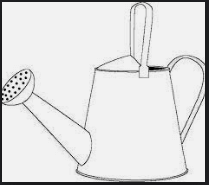QUESTIONS
- Grade 5 pupils were investigating on the best soil for modelling. Which answer did they give?
- When making compost manure which activity helps in quick rotting of the compost heap? (Adding ash, Adding kitchen waste, Sprinkling water)
- Which of the animals below can be classified as harmful
- Mongoose
- Dog
- Goat
- The soil which holds very little water is
- Write True or False
Cotton grows very well in loam soil. - Draw a watering can for practicing drip irrigation.
- Which of the following is NOT a use of water in the farm
- Mixing farm chemicals
- Watering animals
- Watering plants
- Explain the use of a scare crow in a farm
- Write 3 materials that can be used to make a scare crow (3mks)
- Write down 2 ways of soil recovery
- ........................... is the carrying away of top fertile soil by water or wind.
- A ................. bed is a small raised area of land prepared to sow seeds.
- Write down two types of waste which should not be put in a waste pit.
- What is the importance of mulching?
- Removing the weak or thin seedlings to allow space for healthy growing seedlings is called (irrigation, transplanting, thinning)
- Draw the tool used by a farmer for transplanting
- What is the colour of unripe tomatoes?.
- Write down two leguminous crops
- Manure adds ................... to the soil.
- Which animal gives us milk and mutton?
ANSWERS
- clay soil
- Adding kitchen waste
- Mongoose
- sandy soil
- True

- Mixing farm chemicals
- to deter birds or other animals from eating or otherwise disturbing seeds, shoots, and fruit; its name derives from its use against the crow.
- Grass clippings, hay, wood chips, leaves and rags
- use of green manure (uprooted or sown crop parts incorporated or left on topsoil), cover crops, crop rotation and organic compost.
- soil erosion
- seed
- old batteries, pesticides, paint, and car oil
- Mulches conserve the soil moisture, enhance the nutrients status of soil, control the erosion losses, suppress the weeds in crop plants, and remove the residual effects of pesticides, fertilizers, and heavy metals. Mulches improve the aesthetic value of landscapes and economic value of crops.
- thinning

- green
- beans, soybeans, peas, chickpeas, peanuts, lentils, lupins, mesquite, carob, tamarind, alfalfa, and clover.
- nutrients / organic matter
- sheep
Join our whatsapp group for latest updates
Tap Here to Download for 30/-
Get on WhatsApp for 30/-
Download Agriculture Questions and Answers - Grade 5 End of Term 1 Exams 2022 SET 1.
Tap Here to Download for 30/-
Get on WhatsApp for 30/-
Why download?
- ✔ To read offline at any time.
- ✔ To Print at your convenience
- ✔ Share Easily with Friends / Students

